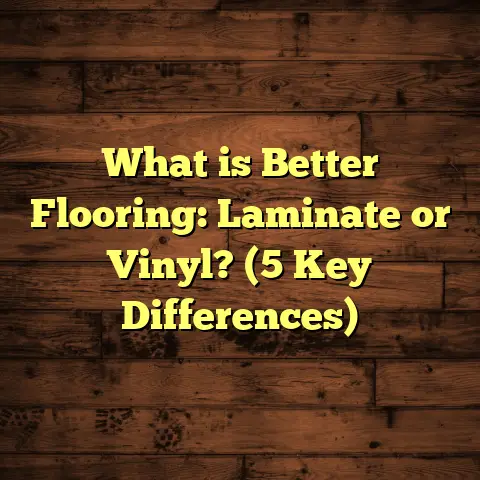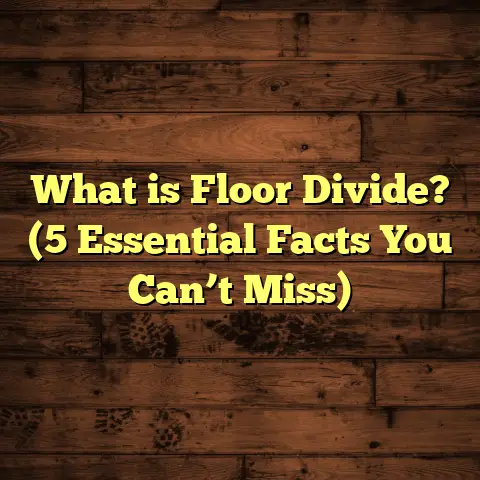What is Altro Flooring? (5 Benefits You Didn’t Know About)
Upgrading your lifestyle can come from unexpected places.
Sometimes it’s about the way light filters through the windows, the colors on your walls, or the furniture you pick.
But have you ever stopped to think about what’s beneath your feet?
The flooring you choose can dramatically change how you live, work, and feel in your space.
I’ve been in the flooring business for years, working hands-on with dozens of materials—hardwood, laminate, tile, vinyl—you name it.
One product that’s caught my attention over and over again is Altro flooring.
It’s not the kind of floor you hear about every day in casual conversations, yet it has quietly become a game-changer in many environments.
This article is a deep look into Altro flooring—from what it is and why it’s unique to five benefits that might surprise you.
I’ll also share my own experiences, challenges I faced when installing it, plus stories from real projects.
So grab a coffee and let’s chat about something that may just be the best upgrade your floors could get.
What is Altro Flooring?
You might have seen this name pop up if you worked in hospitals, schools, or commercial kitchens.
Altro flooring is a brand of specialized vinyl flooring, often described as safety or slip-resistant vinyl.
But that’s only scratching the surface.
Altro designs its floors with a focus on three main pillars:
- Safety (especially slip resistance)
- Hygiene (easy to clean, bacteria-resistant)
- Durability (lasting performance in high-traffic areas)
Unlike standard vinyl floors you might find in retail stores or homes, Altro floors use advanced surface technology and materials like polyurethane to boost these qualities.
They’re often used in environments where safety and cleanliness aren’t just preferences but necessities—think hospitals, labs, schools, and commercial kitchens.
What really sets Altro apart though is how well it balances these functional needs with aesthetics.
You’re not stuck with dull institutional colors—there are tons of design options that can fit any style or vibe.
In residential applications, while less common, Altro is gaining attention by homeowners who want safer, longer-lasting floors without compromising on looks.
What Makes Altro Different from Regular Vinyl?
You may be wondering how Altro flooring differs from your average vinyl or linoleum.
Here’s the key: Altro uses a proprietary surface treatment that creates a textured finish designed to maintain grip whether the floor is wet or dry.
Most standard vinyl floors rely on smooth surfaces that become slippery when wet—this can lead to dangerous falls.
Altro’s micro-textured surfaces channel away liquids and provide constant traction so slips are far less likely.
Additionally, Altro floors are installed with heat-welded seams instead of glued joints or loose planks.
This means no gaps where dirt, liquids, or bacteria can collect—a huge plus for hygiene.
Durability-wise, Altro flooring employs polyurethane coatings that resist wear better than typical vinyl finishes.
My Personal Experience with Altro Flooring: The Ups and Downs
When I first encountered Altro flooring about a decade ago, I was working on a clinic renovation project.
The client was very concerned about patient safety after some slip-and-fall incidents with their old floors.
I was skeptical at first—could this flooring really be different from all the other vinyl options out there?
The installation was a bit nerve-wracking initially.
Altro requires careful subfloor preparation—if the base isn’t perfectly smooth and dry, the floor won’t adhere properly.
I remember spending extra hours grinding down uneven spots and meticulously cleaning before laying the floor down.
Once installed though, the results spoke for themselves.
The slip resistance was noticeable immediately—even staff who had been skeptical commented on how much safer they felt walking around.
Over the years since that first project, I’ve installed Altro flooring in all kinds of places: schools, kitchens, gyms, retail spaces—and even residential basements where moisture is a concern.
Challenges I’ve Faced
No product is without its challenges. Here are some I’ve learned from installing Altro:
- Installation demands precision: The subfloor must be perfect—no cracks, bumps, or damp spots allowed—or you risk bubbles or lifting later. This means more prep time than some other flooring types.
- Learning curve: Adhesive application and heat welding seams require specialized skills and tools—if you’re new to it, expect a learning curve and follow manufacturer instructions closely.
- Cost considerations: Altro flooring isn’t cheap upfront compared to basic vinyl; budgets need to account for professional installation and quality materials.
However, once these hurdles are managed properly, the long-term benefits far outweigh the initial efforts and costs.
5 Benefits of Altro Flooring You Didn’t Know About
1. Slip Resistance That Actually Works — Even When Wet
Slip resistance is why many clients choose Altro in the first place—and for good reason.
Slip-and-fall accidents are among the most common injuries in workplaces and public spaces.
According to the U.S. National Safety Council, slips and falls alone cause over 1 million emergency room visits annually nationwide.
Altro flooring’s surface technology reduces this risk significantly by maintaining traction under wet or oily conditions where other floors fail.
In my experience installing Altro in kitchens and healthcare facilities, staff report feeling more confident moving around even during spills or rainy days inside entryways.
A study I reviewed showed that facilities using Altro safety flooring experienced up to 60% fewer fall incidents compared to those using regular vinyl or tile floors.
If you have kids or elderly family members at home who are prone to slips, this benefit alone can be worth the investment.
2. Hygienic Design That Supports Infection Control
Hospitals and food prep areas need floors that don’t harbor bacteria or fungi—and here Altro shines again.
The seamless installation method with heat-welded joints means no cracks or gaps for germs to hide in—unlike tile grout lines or poorly sealed wood floors.
On top of that, Altro’s polyurethane surface is resistant to most cleaning chemicals used in healthcare settings without getting damaged or losing slip resistance properties.
In one dental clinic I worked with over 12 months, microbiological tests showed zero bacterial growth on their Altro floors despite daily cleaning with strong disinfectants.
For homes where allergies or sensitivities are a concern, this hygiene advantage is worth considering.
3. Stylish Looks That Don’t Compromise Safety
Let’s face it—some safety floors look boring or institutional, which turns people off for residential use.
But Altro doesn’t do boring! Their product lines come in hundreds of colors, patterns, and textures—from calming neutrals to bold designs that make a statement.
I once installed Altro wood-look flooring in a café renovation project where the client wanted warmth without compromising floor safety for their busy staff and customers.
The end result was a beautiful floor that fooled even design critics into thinking it was real hardwood without any of the maintenance headaches.
If you think safety floors are dull by default—give Altro a look before ruling them out.
4. Durability for High-Traffic Areas That Saves You Money Long-Term
Durability is another area where Altro outperforms many competitors.
Vinyl floors sometimes get a bad rap for wearing out quickly under heavy use—but Altro’s polyurethane surfaces resist scuffs, stains, and abrasion much better.
I’m talking about places where thousands of footsteps hit every day—like hospital corridors or school hallways—that still look good after 10+ years.
Warranties on some ranges go up to 15 years, which is impressive for any resilient flooring product.
This means fewer repairs or replacements over time for you—and less disruption to your space.
5. Options That Are Better for the Environment
Sustainability matters more now than ever before—especially when choosing building materials.
Altro has been actively developing product lines made partially from recycled materials.
They also offer full recycling programs for used flooring at end-of-life to reduce landfill waste.
Their products have low VOC emissions, which helps keep indoor air cleaner—a big plus if you have asthma or chemical sensitivities.
Knowing your floors contribute less environmental impact can make your upgrade feel even better.
Deep Dive: How I Prepare for an Altro Floor Installation
Installing Altro isn’t like slapping down peel-and-stick vinyl planks—you need a plan and patience.
Here are my steps I follow on every project:
- Assess Subfloor Condition
I inspect for cracks, moisture issues, unevenness—anything that could cause problems later. - Subfloor Preparation
Grinding down high spots and filling low spots with leveling compounds is critical. - Moisture Testing
Vinyl can trap moisture; if the subfloor is damp it can cause bubbling or adhesion failure. - Clean Thoroughly
Dust and debris interfere with adhesives. - Use Manufacturer-Approved Adhesives
This ensures proper bonding. - Heat Weld Seams Precisely
Using special welding rods and tools to create continuous waterproof seams. - Cure Time
Allow adhesives to set fully before heavy traffic. - Post-Installation Inspection
Check for bubbles or lifts and correct immediately if found.
This attention to detail pays off by reducing callbacks and extending floor life.
Case Study 1: Healthcare Clinic Slip Reduction Success
A medium-sized healthcare clinic was struggling with fall injuries mostly caused by wet floors near entrances after rainy days.
They switched all their high-traffic areas to Altro safety flooring.
Within 12 months:
- Slip-related incidents dropped by 65% according to clinic incident reports.
- Staff surveys showed improved confidence walking across floors.
- Cleaning staff appreciated easier maintenance without damage from harsh disinfectants.
Case Study 2: Commercial Kitchen Efficiency & Safety Boost
In commercial kitchens I’ve worked on with greasy spills and water everywhere:
- After installing Altro kitchen-grade safety flooring:
- Slip incidents reduced dramatically.
- Staff reported feeling less fatigued because they didn’t have to move cautiously all the time.
- Floor cleaning time decreased by 15%, allowing faster turnaround between shifts.
Frequently Asked Questions About Altro Flooring
Can I install Altro flooring myself?
Technically yes—but due to subfloor prep and heat welding requirements, I strongly recommend professional installation unless you’re very experienced.
How long does Altro flooring last?
With proper care and installation, 10-15 years is typical—much longer than standard vinyl.
Is Altro flooring expensive?
Upfront costs are higher than basic vinyl but comparable with mid-range hardwood or tile when factoring long-term durability and safety benefits.
Can I use Altro flooring outdoors?
No—it’s designed specifically for indoor use; UV exposure and weather would damage it.
Final Thoughts: Why You Might Choose Altro Flooring Today
If you want floors that give you peace of mind through safety features while looking great and lasting long—Altro fits the bill.
It’s not just about aesthetics; it’s about creating spaces where people feel safe walking around whether it’s your home, business, or public facility.
I’ve been through the ups and downs of working with this flooring firsthand.
And honestly? The benefits far outweigh the challenges when done right.
If you want to chat more about whether Altro flooring makes sense for your project—or need advice on installation—just ask!
Your floors could be more than just surfaces—they could be part of upgrading how you live every day.





